Hey everyone, lately I've become interested in the katzbalger, and I've seen plenty of pictures of them online so I'm familiar with what they look like, but I'm finding it hard to get my hands on any real information about them. What I do know about katz' is, they were the sidearm favoured by the landsknecht pikemen of the 16th century, and that the name probably comes from the way in which they were used, like vicious cats fighting with tooth and claw.
What I would like to know is where did this unique hilt style come from, I mean I know that some late 15th century hard sword guards that curved into a slight S shape, and that the guards of schiavonesce (Oakeshott type 12) curved even further, did this trend continue to form the closed S guards on katzbalgers, are there any transitional types?
What about the pommel, did the pommel on katz' develope from earlier types, or was it a new innovation?
And last but not least what happened to the katz' after the mid 16th century? I know that in the mid 16th some katz' hilt became more complex, adding knuckle bows and finger rings etc., but what happen after that? Did they continue to evolve into newer more modern types, or did they just cease to be?
Thanks in advance for any help with these questions.
There is what I think of as a proto-Katzbalger ca. 1500, with short, narrow blade, re-curved quillons and a smallish pommel. It's easy to imagine that somebody would have seen the utility in that as a civilian weapon but wanted to "ruggedize" it for combat. You'd want hand protection, a stouter blade and a larger pommel to balance the more substantial blade. The easiest way to create the hand protection is to further re-curve the quillons to form two siderings. The larger pommel provides a canvas for more decoration. Add a few decades of refinement and the Landsknecht passion for flash and you get a very practical combat sidearm with sometimes lavish decoration.
The Katzbalger, like the Landsknecht, was a weapon of its time. By the time of large standing armies organized and maintained by the state you needed stacks of general-purpose munition arms. That argues for a short, tapered DE blade in a hilt with simple hand protection (knucklebow, maybe a sidering). That became the typical infantry sword. Serves much the same purpose but without the flash. Probably more practical since it can thrust as well as cut.
The Katzbalger, like the Landsknecht, was a weapon of its time. By the time of large standing armies organized and maintained by the state you needed stacks of general-purpose munition arms. That argues for a short, tapered DE blade in a hilt with simple hand protection (knucklebow, maybe a sidering). That became the typical infantry sword. Serves much the same purpose but without the flash. Probably more practical since it can thrust as well as cut.
Hey Sean and thanks for the reply do you happen to have a picture of one of these proto katzbalgers.
See far right in this image. The weapons here date 1510-1520 but the type in question was around even earlier and might be of Italian origin. Del Tin has a very similar weapon ( http://kultofathena.com/product.asp?item=DT6166 ) but dates it to the 17th c. I don't know if it's mis-dated or if the form actually persisted that long.
 Attachment: 84.04 KB
Attachment: 84.04 KB
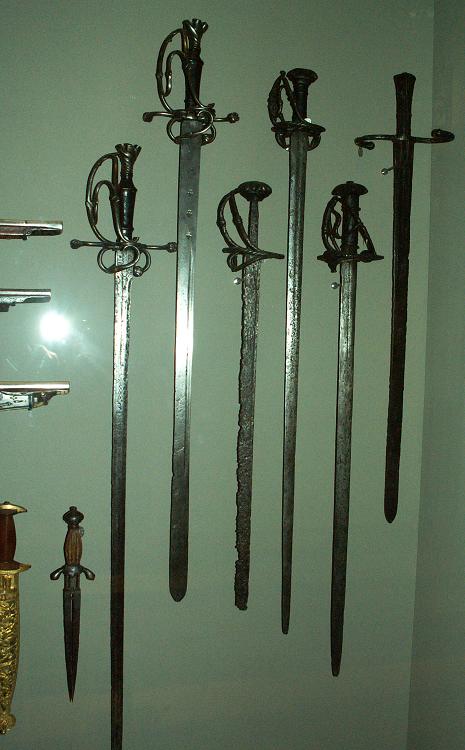

I've started to believe that the katzbalger term defines the sword's general form and function combined with period of use and region of origin. I do not consider the hilt configuration to necessarily be a specific feature that defines what is and what is not a katzbalger.
Generally speaking they have a hilt having a cross-guard that is recurved to form an S-shape or a closed figure-8 mounted to a blade of relatively short length. Is this always the case? Not really, no.
Because of the variety of hilt details, I lean towards considering the katzbalger to be simply the shorter sidearm sword of the Landknecht soldier, though not all Landsknechtschwert could be considered katzbalger. Therein lies the rub: a complete argument cannot be made here, however, as there can be found a great variety to Landsknecht sidearms (Landsknechtsäbel, etc.). The bottom line for me is that like most things relating to this subject of arms and armour, things don't always fit into neat and tidy little boxes.
Which brings me to the next point: I do not consider sword form to be something that evolved over time, but is rather a result of developmment... quite a different matter entirely.
The following swords are examples with various hilt configurations:
 Attachment: 74.11 KB
Attachment: 74.11 KB
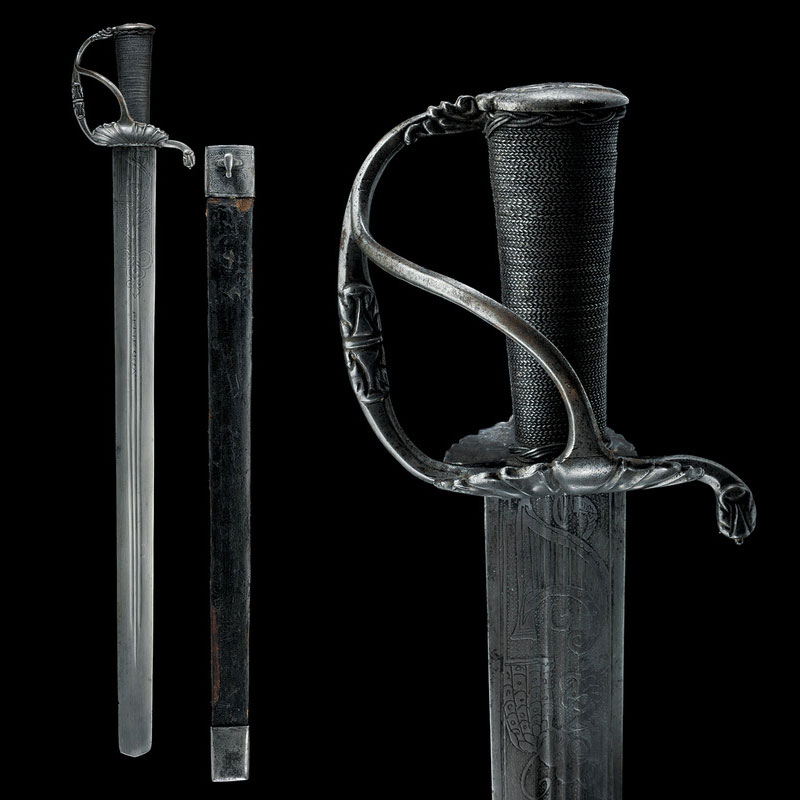
Copyright © Czerny's Auction House
 Attachment: 33.26 KB
Attachment: 33.26 KB

Typical katzbalger hilt, but does the blade length and severe tip disqualify it as such?
 Attachment: 90.55 KB
Attachment: 90.55 KB
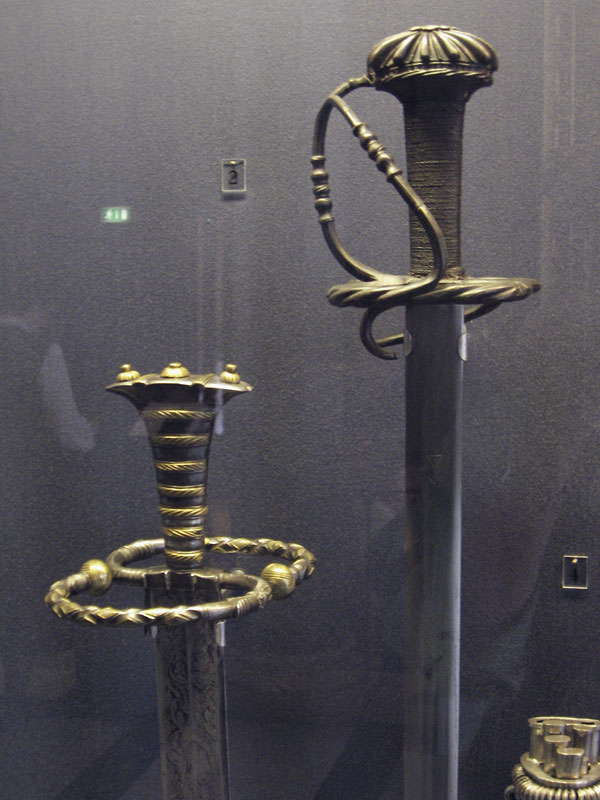
Two katzbalgers
From the Historisches Museum, Dresden
 Attachment: 79 KB
Attachment: 79 KB
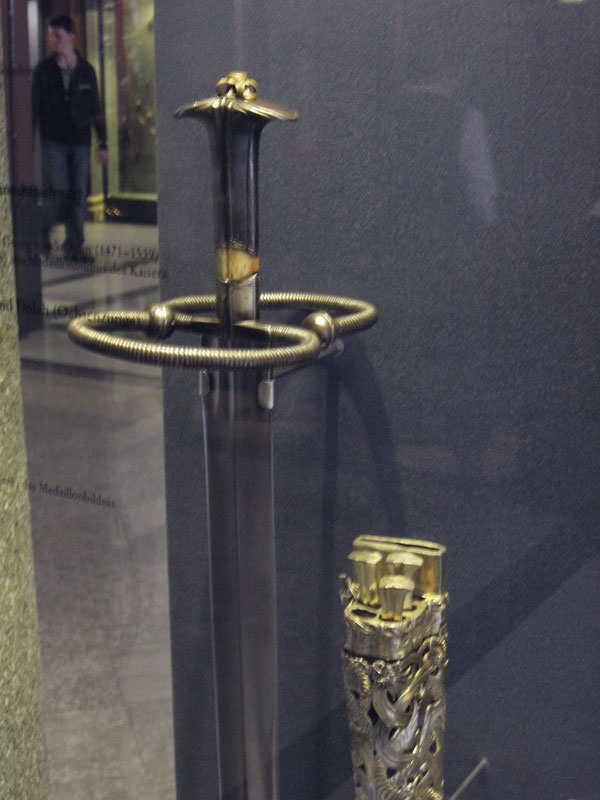
A katzbalger
From the Historisches Museum, Dresden
 Attachment: 31.5 KB
Attachment: 31.5 KB
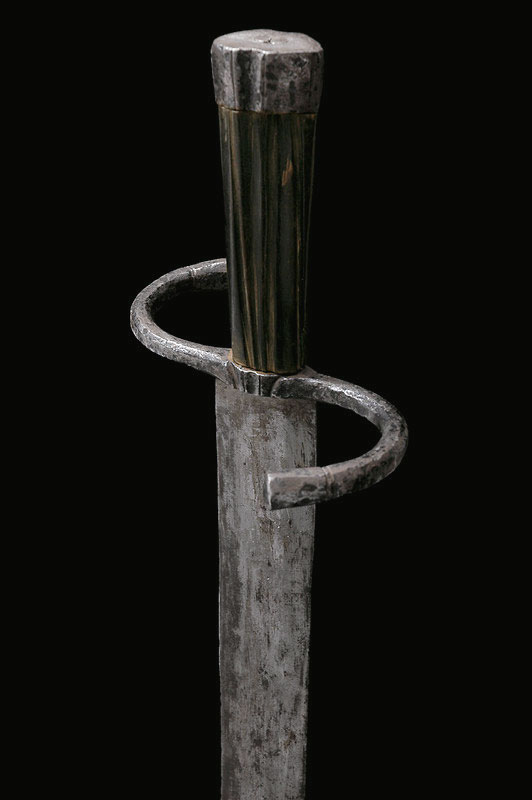
This is considered to be a katzbalger
Copyright © Czerny's Auction House
 Attachment: 62.47 KB
Attachment: 62.47 KB
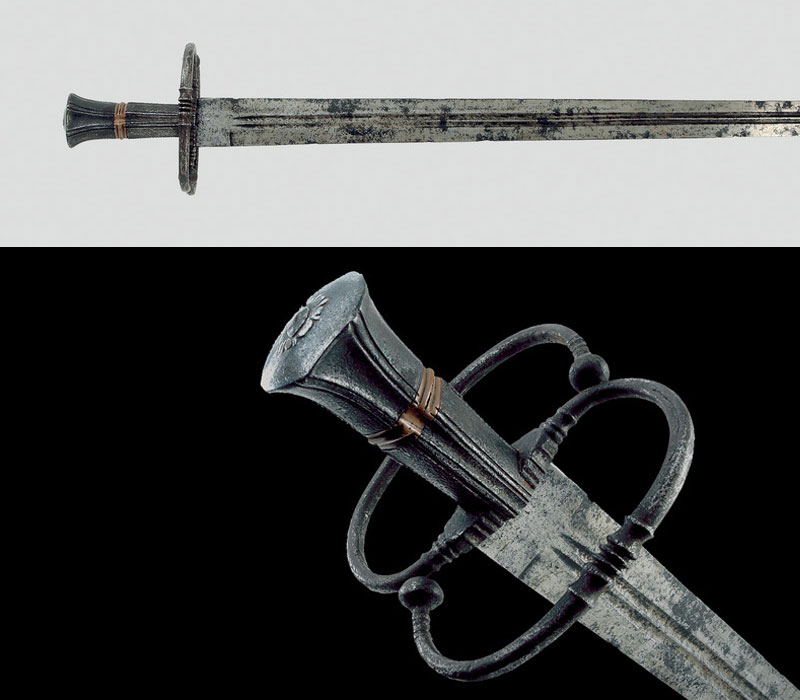
This is considered to be a katzbalger
Copyright © Czerny's Auction House
 Attachment: 94.95 KB
Attachment: 94.95 KB
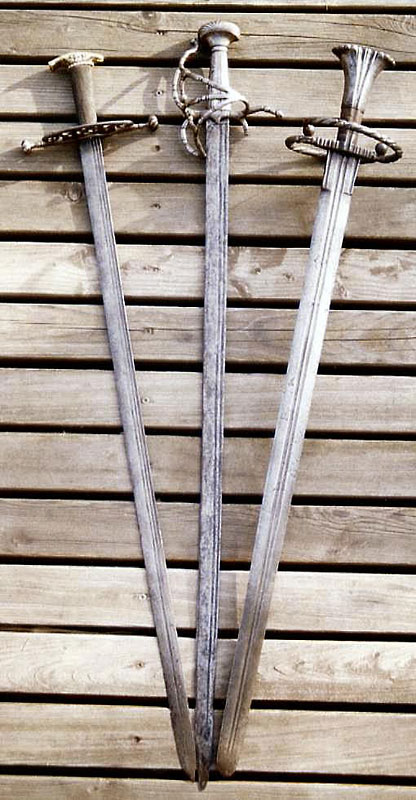
Three landsknecht swords
 Attachment: 58.78 KB
Attachment: 58.78 KB
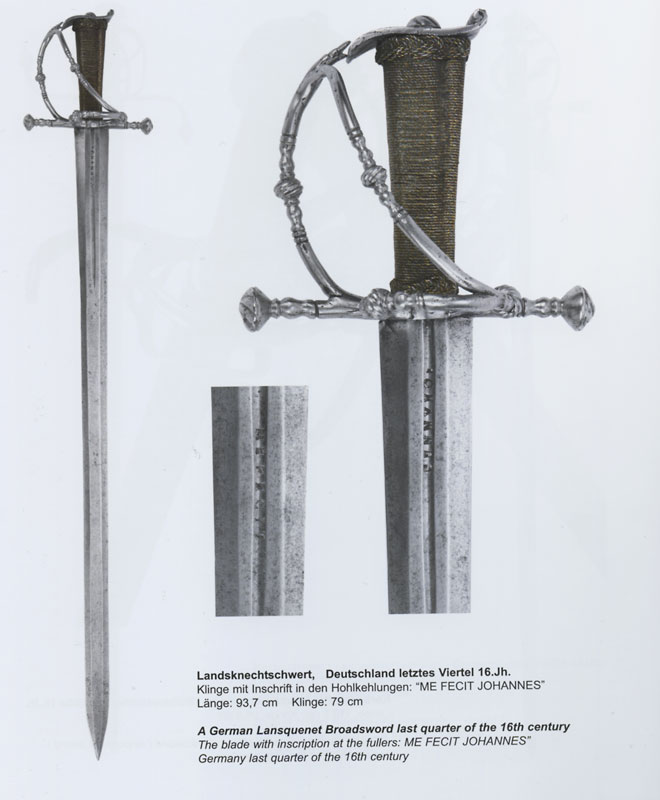
Landsnechtschwert, but not a katzbalger
Copyright © The Rothenburg Collection
 Attachment: 53.5 KB
Attachment: 53.5 KB
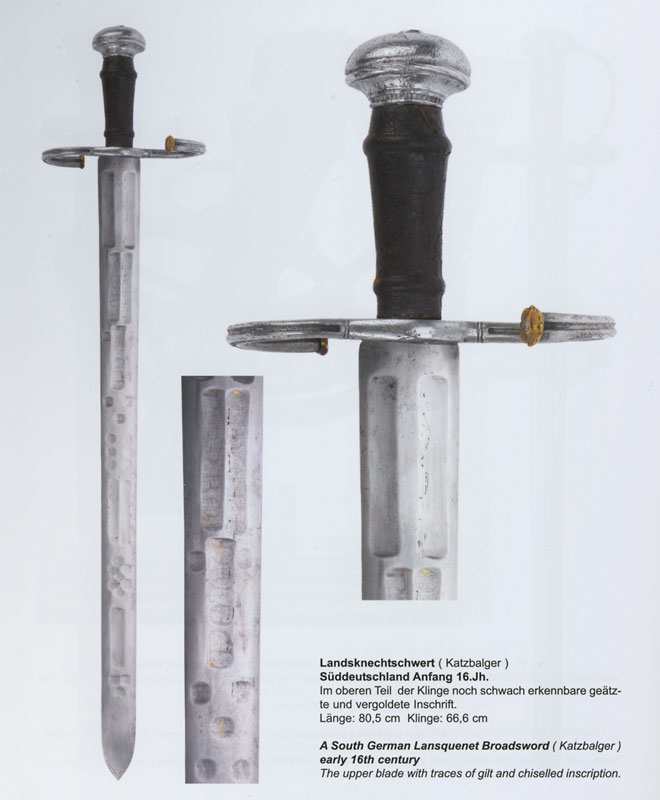
This is considered to be a katzbalger
Copyright © The Rothenburg Collection
 Attachment: 66.19 KB
Attachment: 66.19 KB
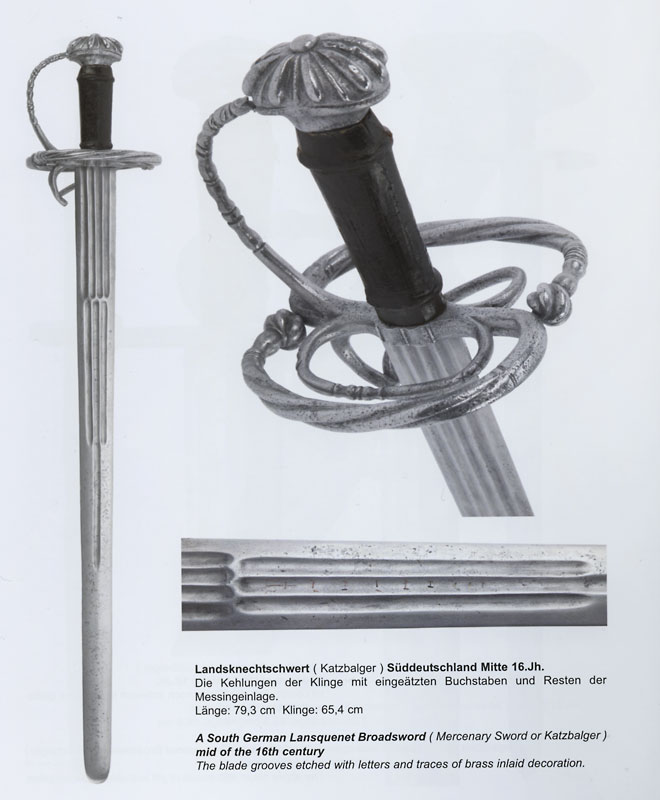
This is considered to be a katzbalger
Copyright © The Rothenburg Collection
 Attachment: 62.34 KB
Attachment: 62.34 KB
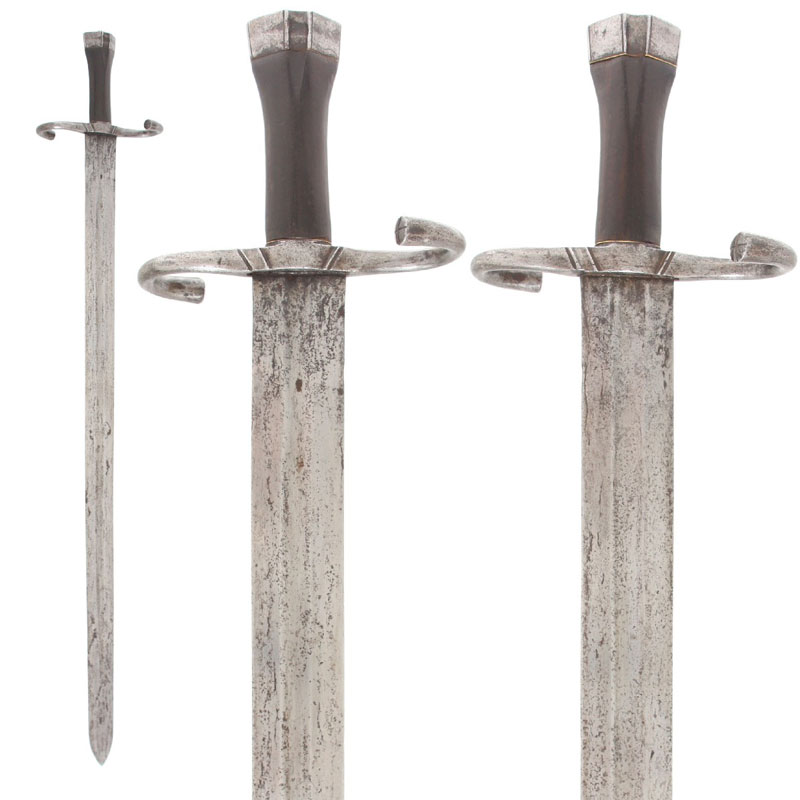
This is considered to be a katzbalger
Generally speaking they have a hilt having a cross-guard that is recurved to form an S-shape or a closed figure-8 mounted to a blade of relatively short length. Is this always the case? Not really, no.
Because of the variety of hilt details, I lean towards considering the katzbalger to be simply the shorter sidearm sword of the Landknecht soldier, though not all Landsknechtschwert could be considered katzbalger. Therein lies the rub: a complete argument cannot be made here, however, as there can be found a great variety to Landsknecht sidearms (Landsknechtsäbel, etc.). The bottom line for me is that like most things relating to this subject of arms and armour, things don't always fit into neat and tidy little boxes.
Which brings me to the next point: I do not consider sword form to be something that evolved over time, but is rather a result of developmment... quite a different matter entirely.
The following swords are examples with various hilt configurations:

Copyright © Czerny's Auction House

Typical katzbalger hilt, but does the blade length and severe tip disqualify it as such?

Two katzbalgers
From the Historisches Museum, Dresden

A katzbalger
From the Historisches Museum, Dresden

This is considered to be a katzbalger
Copyright © Czerny's Auction House

This is considered to be a katzbalger
Copyright © Czerny's Auction House

Three landsknecht swords

Landsnechtschwert, but not a katzbalger
Copyright © The Rothenburg Collection

This is considered to be a katzbalger
Copyright © The Rothenburg Collection

This is considered to be a katzbalger
Copyright © The Rothenburg Collection

This is considered to be a katzbalger
Wow, love those crazy fullers.....
yeah, the 4:3:1 fuller-piece is quite cool, but that one just above it, is a bit too crazy for my taste.
Looks like the key of my car rather than a blade.
What do you think, was there any technical intention in this, or was it just for fancy looks ?
Looks like the key of my car rather than a blade.
What do you think, was there any technical intention in this, or was it just for fancy looks ?
Hey guys, sorry for the delayed response. All I can say is, WOW, I didn't expect that their would be any pics posted as I've been looking for some time and come up with nada.
Nathan, if its possible, I'd much appreciate it if you could put some dates with these pictures. The first picture is of particular interest to me as it seems to me as though it could be a transitional style between the katzbalger and the walloon sword. I would also love to here about other types of landsknechtschwert, especially the landsknechtsabel, which you mentioned.
I completely agree the word katzbalger, more applies to the swords form and function, along with the time and place it came from, it just makes thing easier in a modern context to use the word katzbalger, to refer to short swords with a S shaped or figure 8 guard. As for the word "evolution", I thinks it's appropriate in relation to swords, because, the same way in which all life forms came from a common ancestor and then diversified into the billions of different species, so too did the sword evolve from a common ancestor (a flint blade), then change and adapt with circumstances and technological development, to all the variety of sharp and pointy things we know and love today. In my mind evolution is more like the branches of a tree, than a straight line.
Nathan, if its possible, I'd much appreciate it if you could put some dates with these pictures. The first picture is of particular interest to me as it seems to me as though it could be a transitional style between the katzbalger and the walloon sword. I would also love to here about other types of landsknechtschwert, especially the landsknechtsabel, which you mentioned.
I completely agree the word katzbalger, more applies to the swords form and function, along with the time and place it came from, it just makes thing easier in a modern context to use the word katzbalger, to refer to short swords with a S shaped or figure 8 guard. As for the word "evolution", I thinks it's appropriate in relation to swords, because, the same way in which all life forms came from a common ancestor and then diversified into the billions of different species, so too did the sword evolve from a common ancestor (a flint blade), then change and adapt with circumstances and technological development, to all the variety of sharp and pointy things we know and love today. In my mind evolution is more like the branches of a tree, than a straight line.
I'm in a rush this morning, but it's a good guess that most if not all those are all 1500s... some examples are late 15th century, but by and large the complex varieties are 16th century.
This is the earlier type I mentioned. This one is 1490-1500.
 Attachment: 120.12 KB
Attachment: 120.12 KB
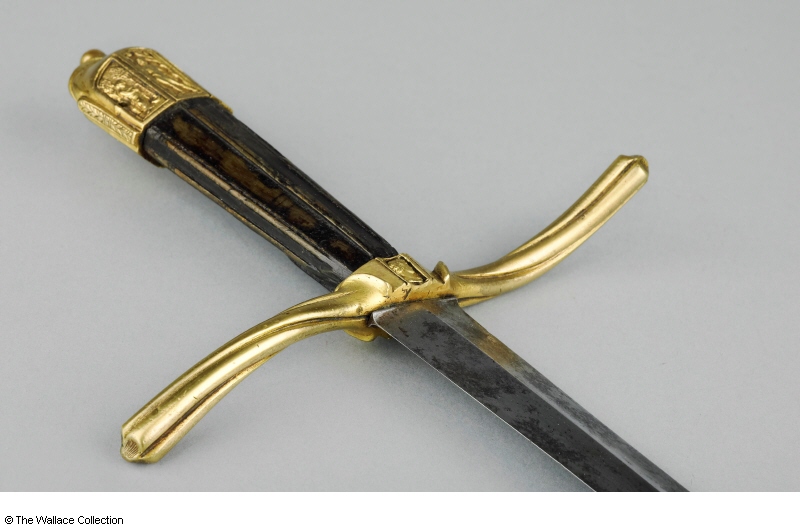

Hey guys and thanks again. Sean, that last one you posted is a real beauty, it's a pity that these swords aren't more widely known.
Hi there everyone,
Regarding the meaning of the word "katzbalger", I thought I'd throw in my 5 cents: A few years ago, being dissatisfied with the usually given meaning, ie. "cat gutter" I decided to look it up in a very thick German - English dictionary. I didn't find the word "katzbalger" but I did find "katzbalgerei" which means "romping" or "to romp". My thinking is that seeing as the words are so close and have the same root, "katzbalger" could literally mean "romper" (as in "It's my little romper.") This would certainly fit with what we know of the style and mentality of the Landsknechts. :D
Regarding the meaning of the word "katzbalger", I thought I'd throw in my 5 cents: A few years ago, being dissatisfied with the usually given meaning, ie. "cat gutter" I decided to look it up in a very thick German - English dictionary. I didn't find the word "katzbalger" but I did find "katzbalgerei" which means "romping" or "to romp". My thinking is that seeing as the words are so close and have the same root, "katzbalger" could literally mean "romper" (as in "It's my little romper.") This would certainly fit with what we know of the style and mentality of the Landsknechts. :D
Interesting idea Shane thanks for sharing.
Wo this is a great thread, full of info and great pictures. I really appreciate it, don't get to see enough Katz. I really want to do one someday. They came in so many shapes and styles while maintaining the theme. Pretty neat, thanks:)
Well, since this thread has gone this direction, I'll some more photos of other examples soon. I'm glad there's some interest because, for me at least, the variety is fascinating as is the craftsmanship. Mix that with the brutal nature of these close-in "cat-fight" type of weapons and it's a real appealing combination.
one of my favorites around1525, engraved with saint barbara holding the martyrs palm and saint paulus holding a sword and a book.
best,
 Attachment: 225.51 KB
Attachment: 225.51 KB

 Attachment: 185.26 KB
Attachment: 185.26 KB
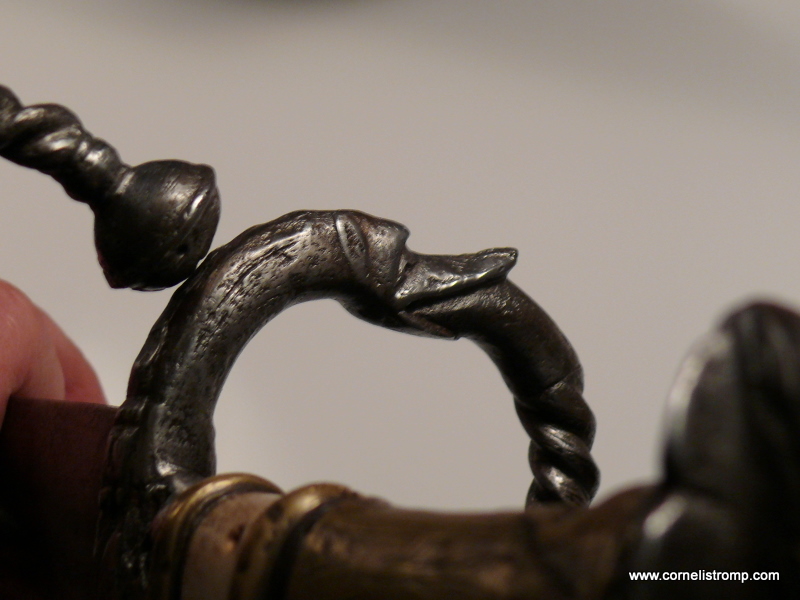
 Attachment: 192.77 KB
Attachment: 192.77 KB
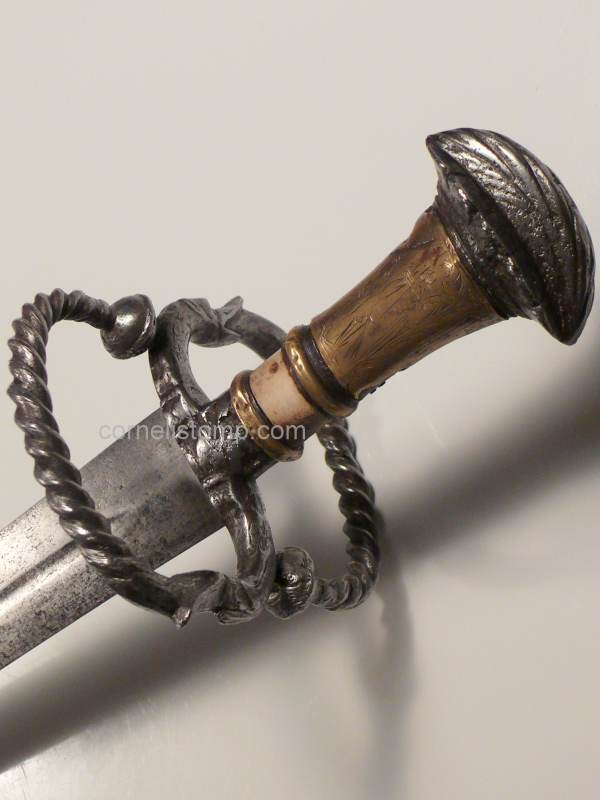
 Attachment: 148.43 KB
Attachment: 148.43 KB
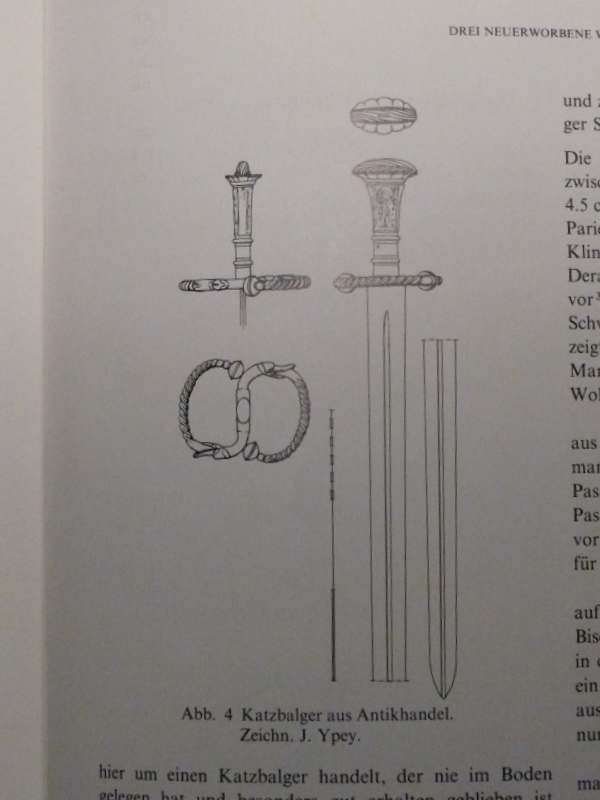
 Attachment: 198.71 KB
Attachment: 198.71 KB
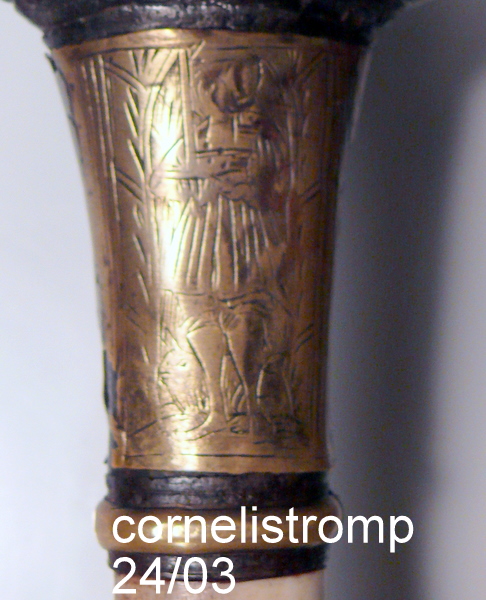
 Attachment: 173.68 KB
Attachment: 173.68 KB

best,






Hi all, fantastic thread!
I too love katzies and have a project sword going this way...
Would anyone have pictures and/or information (i.e. measurements) on Katzbalgers that are in the 90cm - 120cm (3' - 4' ) range? Admittedly, whether or not it is still a "Katzbalger" at this point is questionable, but some of the pics posted by Nathan showing swords circa 1m long pique my interest. I really would be grateful should someone show us more of these swords with wide and long blades, rather short hilts, and typical Katzbalger furnishings (8-shaped or S-shaped guard, etc.)
Thanks in advance and for all the nice pics already posted, these will help me much anyway.
Best,
Simon
I too love katzies and have a project sword going this way...
Would anyone have pictures and/or information (i.e. measurements) on Katzbalgers that are in the 90cm - 120cm (3' - 4' ) range? Admittedly, whether or not it is still a "Katzbalger" at this point is questionable, but some of the pics posted by Nathan showing swords circa 1m long pique my interest. I really would be grateful should someone show us more of these swords with wide and long blades, rather short hilts, and typical Katzbalger furnishings (8-shaped or S-shaped guard, etc.)
Thanks in advance and for all the nice pics already posted, these will help me much anyway.
Best,
Simon
| Simon G. wrote: |
| Would anyone have pictures and/or information (i.e. measurements) on Katzbalgers that are in the 90cm - 120cm (3' - 4' ) range? Admittedly, whether or not it is still a "Katzbalger" at this point is questionable, but some of the pics posted by Nathan showing swords circa 1m long pique my interest. I really would be grateful should someone show us more of these swords with wide and long blades, rather short hilts, and typical Katzbalger furnishings (8-shaped or S-shaped guard, etc.) |
I agree that it's questionable to call such longswords katzbalger simply because they have features typical of the katzbalger: mushroom shaped pommels, S-shaped or figure-8 guards, etc. In one German book I just picked up, they are simply cataloged as Anderthalbhänder (Bastard Sword) with no mention of katzbalger in its description. It is, however, displayed alongside two other katzbalger that are each described as such.
Measurements of the longsword sitting between the two katzbalger:
OL: 1360mm, BL: 1050mm, WT: 2190g
OL: 53.5", BL: 41.375", WT: 4.83 pounds
[ Linked Image ]
[ Linked Image ]
Click images for larger versions
Should anyone have any information regarding this image, please share it here.
Thank you.
 Attachment: 122.8 KB
Attachment: 122.8 KB
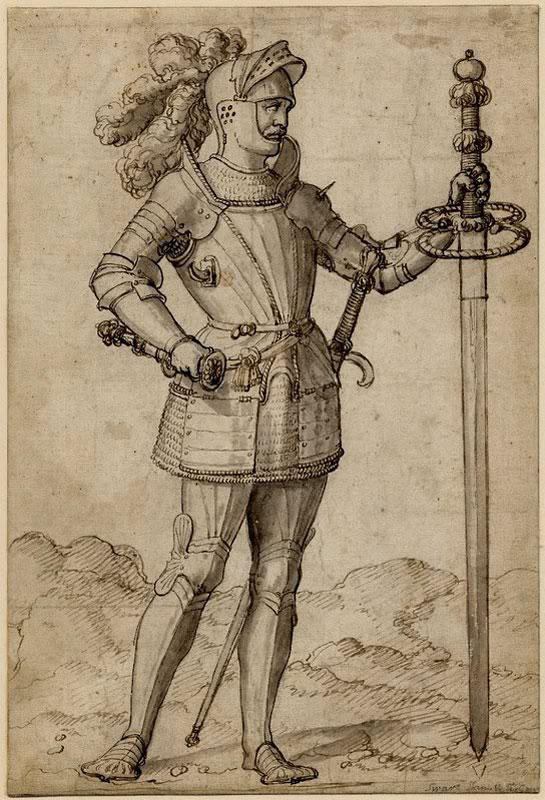
Unknown image
Thank you.

Unknown image
Hi Nathan,
katzbalger 2 hander auctioned at HH 19/05/2001 lot 64.
best,
[ Linked Image ]
 Attachment: 37.27 KB
Attachment: 37.27 KB
[ Download ]
katzbalger 2 hander auctioned at HH 19/05/2001 lot 64.
best,
[ Linked Image ]
[ Download ]
Page 1 of 3
You cannot post new topics in this forumYou cannot reply to topics in this forum
You cannot edit your posts in this forum
You cannot delete your posts in this forum
You cannot vote in polls in this forum
You cannot attach files in this forum
You can download files in this forum
All contents © Copyright 2003-2006 myArmoury.com — All rights reserved
Discussion forums powered by phpBB © The phpBB Group
Switch to the Full-featured Version of the forum
Discussion forums powered by phpBB © The phpBB Group
Switch to the Full-featured Version of the forum